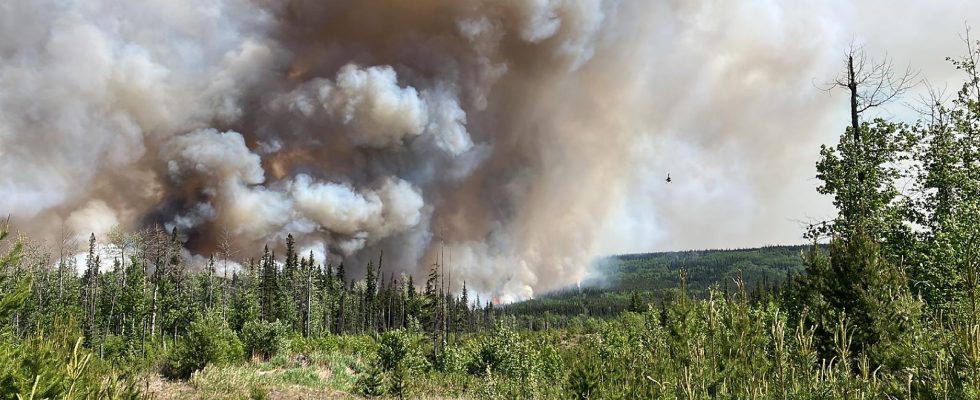Canada is burning. In six months, the equivalent of the area of Iceland or Portugal has disappeared. More than 10 million hectares have already been engulfed in flames this year, a total far greater than anything the country has ever seen, surpassing even the most pessimistic projections by scientists. These figures are expected to worsen further since 906 fires were active on Saturday July 15 in the country, including 570 considered out of control, according to national data from the Canadian Interagency Forest Fire Center (CIFFC).
Since the beginning of July, the situation has taken a dramatic turn in British Columbia (western part of the country) with more than 250 fires starting in three days last week, mainly triggered by lightning. There, the latter can hit the ground up to 10,000 times a day. For example, the Donnie Creek Fire, which has spanned more than 600,000 hectares since May 12, was started by lightning.
According the national institute of public health in Quebec, lightning caused in Canada, between 2003 and 2013, about a third of forest fires and burns 2.3 million hectares per year (more than 4 million American football fields). “In France, it is estimated that 10% of fires are generated by lightning. This is not the same figure everywhere. Canada is a larger and wilder area while, in France, there are more human beings”, emphasizes to The Express Karine Durand, specialist in extreme weather phenomena and the environment.
In France, nearly 10% of fires generated by lightning
Lightning is a natural phenomenon of electrical discharge that occurs when a large amount of static electricity has accumulated in areas of thunderclouds. “In summer, the ground is overheated and the hot air will rise and relax. The rising air mass will then cool, condense into water vapor and create very powerful clouds, explains Nathalie Huret , atmospheric physicist, former director of the Clermont-Ferrand Earth Physics Observatory of Clermont-Auvergne University and CNRS. The electric charge will be distributed in these clouds. We will have a negative part and a positive one, which will then produce luminous phenomena like lightning, with electric discharges”.
Then this lightning will potentially hit the ground. The specialist gives the example of an electrical outlet: “When you unplug quickly, you have an electric arc that opens. These electrons can create a spark and that is what will potentially set fire to brushwood and trees.” As a reminder, the temperature of a flash is around 30,000 degrees.
“Sometimes the lightning remains active inside the tree which can then cause a fire hours after the impact received. This is called latent lightning. When a discharge occurs, the internal parts of the tree increase considerably and suddenly their temperature”, indicates on its site Ingesco, specialist in the production and design of lightning rods, surge arresters and prevention products. As there is little oxygen in a very small space, the combustion is often very slow, lasting for hours or even days.
Note that there are different types of lightning. Some are more prone to forming fires, like hot lightning. “They are also called contained current lightning and they have a much longer and more intense electric discharge than a normal lightning, they tend to burn trees much more easily”, continues Karine Durand. According to one study published in the journal Nature Communication on February 10, 2023, 20-30% of lightning that ignites fires is hot lightning in North America. And for lightning to start a fire, another parameter is also needed: dryness. Thus, the lightning must fall in fairly dry vegetation.
In France, several places were victims of fires caused by lightning. Sunday July 9, the roof of a church caught fire while the department was affected bymajor thunderstorms to Descartes (Indre et Loire), a few kilometers south of Tours. “The roof is completely burned, the bell tower has collapsed”, detailed the sub-prefect of Loches, André Joachim, at the microphone of France 3 Centre-Loire Valley.
Saturday June 17, while the Dordogne was placed in yellow storm and hail vigilance, lightning caused a fire to start in a wood in Saint-Martin-l’Astier, according to the newspaper South West. In early June, lightning was responsible for a fire that burned more than 4 hectares of forest in the Landes. On the Landes massif, the meteorological context is particular: “It is mainly characterized by more frequent thunderstorms, recurrent lightning phenomena followed by “resurgence fires”, declared the Assessment Mission relating to the defense of the forest against the fire in June 2016.
By 2090, 40% more hot lightning
Difficult to prevent these lightning fires, because it is the consequence of a whole meteorological cycle: “At the level of research, we are starting to have laws between the number of flashes and the intensity of the cloud. But these clouds – there remain very opaque and there are a lot of lightning inside the cloud that we cannot detect, admits Nathalie Huret. The subject is all the more important as the number of lightning fires should increase in hot zones and the Mediterranean due to climate change, according to a 2018 study in the scientific journal Geophysical Research Letters.
“By 2090, it is estimated that there will be 40% more hot lightning on average in the world, with differences depending on the country”, adds Karine Durand. For example, in India, 147 people were struck by lightning in the space of ten days in July 2020, an abnormally high mortality for this natural phenomenon. “All extreme events will become more intense. At our latitudes, in France and in Europe, we will have the climate of North Africa. The whole system goes up”, continues Nathalie Huret. However, meteorologists cannot say that there will be more storms, a complex and very localized phenomenon, with global warming. In France, lightning strikes have only been measured since 2000, a period of time still too short to draw conclusions.
